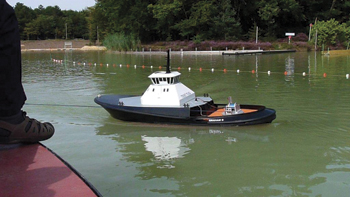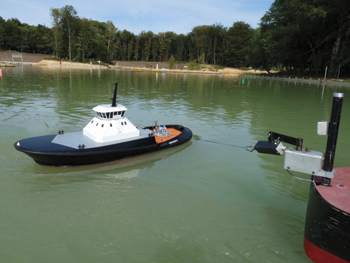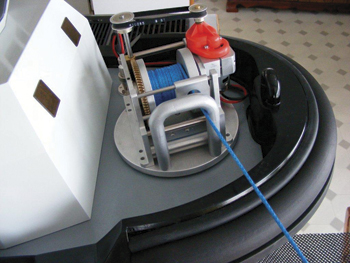The Auto Position Escort Winch (APEW) system, pioneered by JonRie InterTech, represents emergent technology that allows escort tugs to assist with utmost maneuverability, increased safety and better reaction time for a pilot or ship operator to act in the event of a steering or propulsion failure.
Escort tugs include the Voith Schneider Propeller system and azimuthing stern drive (ASD) systems and highly maneuverable tractor tugs and are able to change their thrust instantly. They are required to escort large vessels such as large crude carriers, LNG tankers and gas tankers. An escort differs from a tow in that the tractor tug is tethered to the large vessel in the event that it loses propulsion or steering. The tug is able to provide propulsion and to steer the large vessel, if required, thereby preventing collision and subsequent damage.
Towing configurations present risks to the tug as well. Conventionally, a tow point takes place through a fairlead or staple aligned with the centerline of the tug. If a vessel loses steering and the escort tug is to take over, the tension could cause enough force at such a pivot point to jeopardize the stability of the escort tug by heeling it enough to capsize.
The two most popular modes used to steer a tanker are indirect and powered direct towing or escorting maneuvers. In both modes the escort tug is dragged through the water to create the forces needed to steer a tanker in an emergency situation, thus creating a point at which the tug will heel over if not operated properly by the master.
 |
 |
|
A 1:24 scale model of the Auto Position Escort Winch undergoes analysis in a test pond at the Port Revel Shiphandling Training Centre in France. By comparing instant bollard pull readings at various angles and forces, the maneuverable winch proved that it can improve stability, stretch reaction time, boost escort capability and even reduce the required horsepower. |
The APEW changes the angle from the vessel to the tug in such a way to reduce the heeling angle and actually keep the tug more stable. “It’s safe for the tug,” said Ron Burchett, owner of Burchett Marine. Burchett is an experienced tugboat captain, and additionally has spent half his life running a shipyard.
“The tug can do a lot more as opposed to doing 10 or 11 knots and the boat is almost on its side and water is way up the cabin and would get deck edge immersion,” Burchett said. “Very seldom (with the auto escort winch) do we get deck edge immersion when we do this.”
With a rotating winch, the tow point rotates with the winch, aligns with the line of force and enables a righting moment upon the tug, increasing safety and providing more control and preventing damage. The winch offers the versatility of rotating through a wide radius and allows it to be locked on centerline for normal winch operations.
“Basically it’s like a sailboat tacking out wind,” said Burchett. “You’re using the keel to hold you against the wind and the sail so you can make way. It means that when they go from side to side (of the escorted vessel), there’s a continuous strain on the line. So now there can be less strain on the line and less wear and tear on the hull. You’re getting a true reading off the winch too, because it’s a direct pull. You’re not bending around a staple and not losing to the friction around the staple. You’re getting a very direct read of what the line pull is.”
Brandon Durar, founder of JonRie, said escort operations require a tether of the tug to the vessel and provide an at-the-ready assist to the vessel should they lose steering. A maneuverable winch allows the tug to gain better control quicker, allocating more time to prevent a collision.
“As the tug industry entered the turn of the century, it became apparent the safest way to assist tankers and large containerships was to be tethered to the stern of the vessel so the tug would be the emergency steering in case of a rudder failure,” Durar said. “The reaction time for a steering loss or casualty might be 11 seconds. An auto escort winch might stretch the reaction time to 16 seconds.”
For a ship handler, a mere five seconds could be a multi-million dollar difference in damage and, more importantly, personnel safety in a maneuvering situation. “As tanker escorting has become mandatory for more ports worldwide,” Durar said, “escort winches have become more advanced to handle the extreme steering forces.”
Burchett pointed out that with escorting, bridge commands from the pilot are different around the world, but they achieve the same thing — steering and propulsion on demand. “When you’re escorting, you’re there in case of an emergency, and the tug becomes emergency steering for the tanker and also the braking and propulsion end of it,” said Burchett. “If the tanker is coming up to a bridge and the steering froze, the (escort tug) would become the rudder. If it dropped off power, which happens occasionally, the tug could push on the vessel and become the propulsion and the steering, or if you wanted to slow ‘em down, you could pull back at the same time — in other words, putting your brakes on and steering at the same time.”
Burchett said a conventional tug can’t exert as much lateral force as an escort tug, because escort tugs are built specifically with enough skeg on the keel to enable it to operate and steer. “First you must have a designated escort tug, then the winch enhances the whole operation,” he said. “It makes it safer and more efficient. The winch rotates around to the line of pull and moves nine or 12 feet off centerline, and … that wants to pull the boat back up instead of tipping it over because we’re doing it at 10 knots. It’s more efficient because you don’t need as much horsepower to hold it in escort mode because you expose the keel forward of the tow point,” Burchett said. “I’m using a quarter to two-thirds less fuel, because I don’t have to put as much force into the boat to hold it in that position.”
McAllister Towing & Transportation, in Staten Island, N.Y., recently announced plans to build a 5,150-hp twin ASD tractor tug, Eric M. McAllister. While the new escort tug will have a JonRie 250 Escort winch, and not the APEW, McAllister understands the need to have new and better technology to enable escorts as larger ships require the assist.
“Right now with a conventional tug, you need a higher, wider boat to do what the auto escort winch allows you to do,” said Marty Costa, McAllister’s engineering manager. The APEW “allows you to do more with less.”
The auto escort winch rotates at a wide radius. This versatility allows the pivot point to change and the tension to be controlled better. Ultimately, the tug has a better capability to take over, steer or control the vessel when the vessel is escorted. Another advantage of the rotating winch is that the tow point may rotate towards the line of force and reduce the otherwise high side loading on the winch.
JonRie tested its winch in a tow tank at the Davidson Laboratory at Stevens Institute of Technology in Hoboken, N.J., and later in a tank at Port Revel in France. Engineers compared the rotating winch’s performance to that of a conventional fixed staple tow. They found that the APEW was able to increase the tug’s steering force significantly.
JonRie tasked a U.S. naval architect to perform an analytical study to compare a conventional fixed staple escort tug and an escort tug using the APEW at 8 knots and 10 knots, escorting a tanker using a 105-foot hull. At 8 knots, the APEW enhanced the tug’s steering force by 13 percent and its braking force by 2 percent.
At 10 knots, the steering forces appeared to increase to approximately 15 percent to 17 percent. The lift increased to approximately 8 percent as again the test data dropped off rapidly due to the tug correcting the direction of the tanker.
“As the industry moves forward into the future, winch design needs to be one with tug, and the tug become an escorting system with the integration of all the vessel components,” said Durar. “Winch design needs to embrace systems that enhance the tug’s performance and rethink systems that don’t work. Winch design also needs to put some of the control back in the hands of the master and also back up the master with sensors and systems to prevent critical condition.”
Burchett said the APEW takes the technology of escort winches to the highest level so far. “Other technologies have been evolving so far to improve escort technology, but none have done anything by changing the exit point,” he said. “This takes the technology up to a new level. If you were racing it would be like moving up a notch.”
“It’s physics,” said Burchett. “It’s pure physics. It’s nothing more other than just applying the physics that are available and taking it to the next level.”

